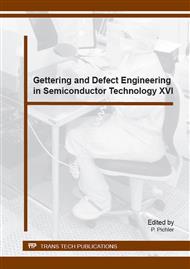p.3
p.10
p.15
p.21
p.30
p.35
p.41
p.51
Recent Progress of Crystal Growth Technology for Multi-Crystalline Silicon Solar Ingot
Abstract:
In recent years, silicon solar cells continue to remain the main stream in photovoltaic (PV) industry, particularly of made from multi-crystalline silicon (mc-Si). The progress of crystal growth technology for mc-Si ingot using directional solidification (DS) is particularly significant. With the breakthrough of the so-called high-performance (HP) mc-Si technology in 2011, the mc-Si solar cell efficiency had increased from 16.6% in 2011 to 18 % or beyond in 2013. Nowadays, HP mc-Si, solar cells from a normal screen-printing aluminum back surface field (Al-BSF) production line could easily reach 18.3%. With the passivated emitter and rear cell (PERC) structure using PECVDalumina passivation, an average efficiency of over 19.2% could also be obtained. The emerging of HP mc-Si almost blocked the development of mono-like technology in 2012, and pushed p-type mono-Si cells to higher efficiency by using advanced technology. Unlike the conventional way of having large grains and electrically-inactive twin boundaries, the growth of HP mc-Si is from small and uniform grains having more random GBs. The grains developed from such grain structures significantly relaxes the thermal stress and suppresses the massive generation and propagation of dislocation clusters. Currently, most of commercial mc-Si ingots are grown by this concept, which could be implemented by seeded with small silicon particles or using nucleation agent coatings. The seeded growth has been well adopted in industry. However, the melting control of the seed layer and the thick red zone induced remain key issues in mass production. Several methods have been considered to resolve these issues with some success. The use of nucleation agent layers is a simpler approach, but the control of initial grain structures remains challenging.
Info:
Periodical:
Pages:
21-29
Citation:
Online since:
October 2015
Price:
Сopyright:
© 2016 Trans Tech Publications Ltd. All Rights Reserved
Share:
Citation:


